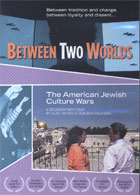
Between Two Worlds 2011
Distributed by Bullfrog Films, PO Box 149, Oley, PA 19547; 800-543-FROG (3764)
Produced by Snitow-Kaufman Productions
Directed by Alan Snitow and Deborah Kaufman
DVD, color, 70 min.
College - General Adult
Jewish Studies
Date Entered: 03/26/2012
ALA Notable: ala.gif
Reviewed by Maureen Puffer-Rothenberg, Valdosta State University, Valdosta, GA
At the 29th annual San Francisco Jewish Film Festival a screening of Rachel (2009) led to charges of anti-Semitism against Festival organizers and sparked weeks of angry protest. The controversy inspired filmmakers Alan Snitow and Deborah Kaufman to examine whether opposing Israel’s occupation of Palestine made them less Jewish—and according to whom?
Their film combines interviews with Jewish leaders, contemporary and archival footage to look at American Jews’ positions on the Israeli-Palestinian conflict, and the rationales they give for their views. A range of interviewees discuss whether Jews are called upon to take any political stance; some cite the prophets, others the political roles Jews have played throughout history. The filmmakers explore their own family histories for the origins of their political sensibilities. Kaufman’s father was a committed Zionist in his youth, and later struggled to accept his daughters’ reinterpretations of traditional Judaism. In the 1930’s Snitow’s mother was a member of the Communist Party; in the 1950’s and 60’s she campaigned for civil rights as a leader in the American Jewish Congress. Kaufman and Snitow believe their commitment to equality and justice is an inherent part of being Jewish—as it was for their parents.
Extended footage of a Student Senate meeting at the University of California, Berkeley offers a look at the next generation, as the Senate hears from the student body and votes on a proposal to divest from U.S. corporations that sell weapons to Israel (the motion is defeated).
The film touches briefly on other polarizing issues including religious observance, responses to the Holocaust, political views, and changing roles for women. This is a thoughtful presentation of the filmmakers’ position and its rationale and is recommended with the caveat that it does not give much quarter to the opposing view. Viewers may select from 18 chapters; SDH captions are optionally provided.
Awards:
- CINE Golden Eagle Award